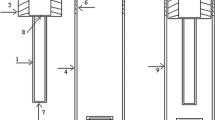Abstract
Pressure balance is a pressure standard used to measure pneumatic or hydraulic pressure. It operates using the produced force value over a calibrated area. The force is applied to a piston-cylinder assembly, with the gravitational force of the calibrated loaded weights realised by a piston-cylinder (PC) assembly. Such instruments are also called piston gauges (PGs) and are used as primary-level standard instruments in pressure metrology. The current pressure ranges for conventionally available piston gauges start from a few kilopascals, which is the lowest achievable pressure limit value for a piston gauge. Owing to the pressure limitations, it is not possible to use piston gauges for certain small pressure ranges. To overcome such limitations, Fluke launched an instrument which is a non-rotating force-balanced piston gauge FPG model 8601 from 1 to 15 000 Pa. The TUBITAK UME National Metrology Institute of Turkey bought and performed a metrological characterisation of his FPG8601 standard up to 15 kPa pressure range. First, the effective area of the piston-cylinder unit (PCU) of FPG8601 was determined using the cross-float method offered by the manufacturer, against the reference piston pressure balance of the model PG7601. The obtained effective area calibration results were compared with those of previous calibration certificates by Fluke and Minerva. All results were within the 7-ppm agreement interval. Second, the effective area value obtained from the calibration was entered into the FPG software and the pressure values indicated by the FPG8601 standard were checked against the reference pressure values applied from the reference piston gauge. The deviations and assigned uncertainties were evaluated. It was concluded that the results after characterisation were within the tolerance values declared by the manufacturer.













Similar content being viewed by others
References
S. Naris, N. Vasileiadis, D. Valougeorgis, A.S. Hashad and Sabuga W, Computation of the effective area and associated uncertainties of non-rotating piston gauges FPG and FRS, Metrologia 56(2019) https://doi.org/10.1088/1681-7575/aaee18.
J. Tesar, P. Repa, D. Prazak, Z. Krajicek and L. Peksa, The new method of traceability of a force-balanced piston gauge used as primary vacuum standard. Vacuum, 76(2004) 4. https://doi.org/10.1016/j.vacuum.2004.04.008.
R.S. Dadson, S.L. Lewis, G.N. Peggs, The pressure balance: theory and practice, HSMO, London, 233 (1982).
A. Ooiwa, Novel nonrotational piston gauge with weight balance mechanism for the measurement of small differential pressures, Metrologia 30(1993/94).
R. Haines and M. Bair, Application of a new method for the automated calibration of very low gauge and absolute pressures in a commercial calibration laboratory, Measurement Science Conference (2002).
https://us.flukecal.com/literature/articles-and-education/pressure-calibration/application-notes/typical-pressure-measuremen, accessed on 11 January 2022.
https://download.flukecal.com/pub/literature/3031083C_EN_FPG8601_DS_w.pdf, accessed on 11 January 2022.
R. Haines and M. Bair, A method of traceability for an FPG8601 force balanced piston gauge to define pressures in the range from 1 Pa To 15 kPa in gauge and absolute measurement modes, XIX IMEKO World Congress (2009).
P. Delajoud and M. Girard, A force balanced piston gauge for very low gauge and absolute pressure, NCSL International Workshop and Symposium (2002).
P. Otal and J.C. Legras, Metrological characterization of a new standard, in absolute and gauge pressure modes, Metrologia 42 6. https://doi.org/10.1088/0026-1394/42/6/S15.
M. Rantanen and S. Semenoja, Results on the effective area of the FPG-type digital piston manometer of MIKES, Metrologia, 42(2005) 6. https://doi.org/10.1088/0026-1394/42/6/S03.
A.S. Hashad, S. Ehlers, O. Jusko and W. Sabuga, Characterization of a force-balanced piston gauge as a primary pressure standard, Measurement 131. https://doi.org/10.1016/j.measurement.2018.09.016
J.C. Hendricks and D.A. Olson, Nist experience with non-rotating force-balanced piston gauges for low-pressure metrology, XIX IMEKO World Congress (2019).
https://us.flukecal.com/products/obsolete-products/fpg8601-automated-calibration-system?quicktabs_product_details=4, accessed on 11 January 2022.
Acknowledgements
This research was supported by TUBITAK National Metrology Institute (TUBITAK UME).
Author information
Authors and Affiliations
Corresponding author
Ethics declarations
Conflict of interest
The authors declare no conflicts of interest.
Additional information
Publisher's Note
Springer Nature remains neutral with regard to jurisdictional claims in published maps and institutional affiliations.
Rights and permissions
Springer Nature or its licensor holds exclusive rights to this article under a publishing agreement with the author(s) or other rightsholder(s); author self-archiving of the accepted manuscript version of this article is solely governed by the terms of such publishing agreement and applicable law.
About this article
Cite this article
Durgut, Y. Metrological characterisation of force-balanced piston gauge up to 15,000 Pa pressure range. MAPAN 38, 147–159 (2023). https://doi.org/10.1007/s12647-022-00586-x
Received:
Accepted:
Published:
Issue Date:
DOI: https://doi.org/10.1007/s12647-022-00586-x




